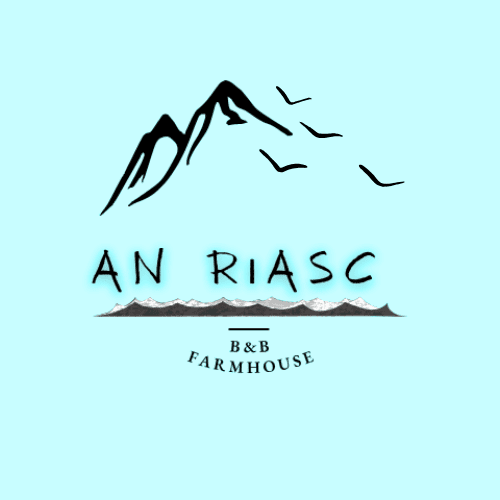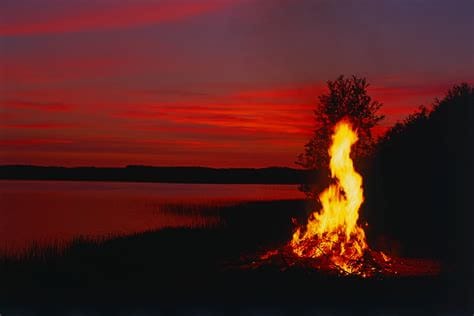Bonfire Night in Dingle: An Ancient Ritual of Light, Community, and Renewal
As the sun slips behind the hills of the Dingle Peninsula on June 23rd, something quietly magical stirs across this wild corner of Kerry. Here at An Riasc, we invite you to feel the glow of a tradition that blends ancient light, communal warmth, and seasonal renewal: the St. John’s Eve bonfire, or Tine Chnámh — the “bone fire.”
Here at An Riasc, we invite guests to witness — or even take part in — this gentle, glowing celebration of light, release, and rebirth.
A Fire Older Than Memory
From Celtic Solstice to St. John’s Eve
Long before Christianity arrived in Ireland, mid-June marked a crucial turning point in the Celtic year, a moment deeply tied to seasonal cycles and community life. During this period, fires were lit on hilltops to honor the sun at its height and to protect land, homes, and animals from harm.
Later on, as Christianity took root, these earlier fire traditions did not disappear. Instead, they evolved, becoming associated with St John’s Eve on June 23rd, ensuring that the flame — both literal and symbolic — continued to burn through the centuries.
Despite these changes, many older customs survived, particularly in the West of Ireland, where rural life preserved practices that disappeared elsewhere. For example, in counties like Kerry, bonfires were traditionally built from turf or whin (furze) and lit on elevated ground — a detail still recalled in West Kerry oral tradition.
Moreover, the name Tine Chnámh (“bone fire”) is believed to come from the much older practice of burning bones for protection and purification. This ritual, centered on driving away misfortune, expresses the Celtic belief that fire could cleanse the community at the threshold of a new season.
To explore these traditions further, see the recent folklore summary in the
➡️ Irish Farmers Journal – “St John’s Eve Traditions and Superstitions” (2023)
And for a more in-depth, classic reference on Irish seasonal customs:
➡️ Kevin Danaher – The Year in Ireland
What to Expect: An evening of Flame and Belonging
Across Dingle, Ballydavid, and Brandon, you may notice small groups gathering just before sunset. There is no official event, no staged performance — simply a living tradition quietly tended by local families.
You may encounter:
🔥 A crackling fire built from driftwood, turf, or furze
🎶 Songs shared between generations
🍀 Children hopping over low embers for good luck
🥔 Potatoes wrapped in foil and roasted in the coals
📜 Simple handwritten intentions offered to the flames
🌬️ The unmistakable sense of standing inside something ancient
“You write a worry on a scrap of paper, watch it burn, and feel lighter. That’s the magic.”
— Máire, a lifelong Dingle resident
Some parts of West Kerry have kept the ritual alive quietly, without advertising. Midsummer fires in rural Ireland today tend to be informal, communal, and unpublicised, appearing in different spots each year depending on weather, land use, and local families.
It is said that people who have difficulty conceiving make the pilgrimage to the summit of Mount Brandon on that day, seeking a blessing or a miracle of fertility. While not universally recorded in historical sources, the mountain has long been regarded as a place of spiritual significance: pilgrims traditionally climb via the ancient route known as Cosán na Naomh (“the Saints’ Road”), circle a path at the summit nine times reciting the Rosary, cast a pebble on a cairn, and then drink from St Brendan’s well.
A Tradition of Letting Go
In Irish culture, fire doesn’t just illuminate, it releases.
On this night, many people symbolically let go of what weighs them down by casting a word, a thought, or a burden into the fire.
At An Riasc, we often offer guests a simple, optional ritual:
Write a word, a wish, or a weight — and feed it to the flame.
“There’s a deep stillness in doing this beside strangers. Somehow, the land feels like it’s listening.“
This gentle act links directly to older customs where households kept a small midsummer fire for protection and blessing.
If You’re in Dingle on June 23rd…
If you’re hoping to experience Bonfire Night in Dingle, it helps to know a few local tips.
First, ask someone from the area, as bonfires tend to appear in different places each year and are rarely advertised.
Then, make sure to bring a warm layer, since Atlantic evenings can cool quickly even in late June !
You may also choose to offer something symbolic to the fire — a flower, a wish, or a written intention. For those seeking a special experience, some people make the pilgrimage to the summit of Mount Brandon on this day. Whether or not one believes in the miraculous, the journey up the mountain offers a sense of connection to centuries of local ritual and the stunning Kerry landscape.
At the same time, remember to be respectful, as several bonfires take place on private land or near sacred spaces.
Finally, keep in mind that the tradition is highly weather-dependent: some years only a few fires are lit, while in other years they are plentiful across the peninsula.
Fire and Philosophy at An Riasc
At An Riasc, Bonfire Night is a reflection of the way we welcome our guests. Everything about our midsummer hospitality is shaped by the land around us:
• We honour the wisdom of nature’s cycles, letting the long light of June set the rhythm of the day.
• We embrace ritual and stillness, creating a space where you can truly slow down, breathe, and rest.
• We believe that letting go — even through a simple symbolic gesture — opens the door to lightness and joy.
• And we practise a kind of hospitality rooted in connection, not spectacle: warm conversation, shared stories, and a sense of belonging.
This is why staying at An Riasc during midsummer feels different. Our approach is slow, soulful, and deeply woven into the heritage of West Kerry. If you’re dreaming of a stay that nourishes both body and spirit — a place where the beauty of the landscape meets the comfort of a family-run farmhouse — An Riasc is the perfect home for your summer escape.
✨ Book your midsummer stay and experience the magic of June 23rd in the heart of the Dingle Peninsula.
Other Summer Rituals on the Dingle Peninsula
If you’re staying into July or August, explore more seasonal traditions:
Garland Sunday (late July) — Pilgrimage to Mount Brandon
Lughnasadh (early August) — First harvest festival with music & storytelling
Traditional Seisiúns — Weekly Irish music nights in local pubs
- No booking fees
- Incredible views
- Peaceful rural escape
- Ideal for families, friends, or longer stays
- Warm personal welcome

